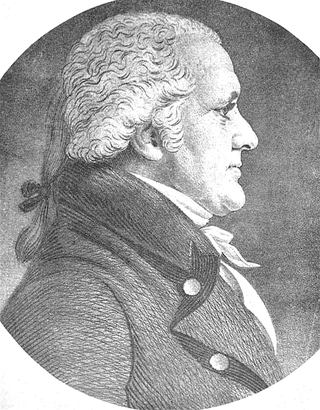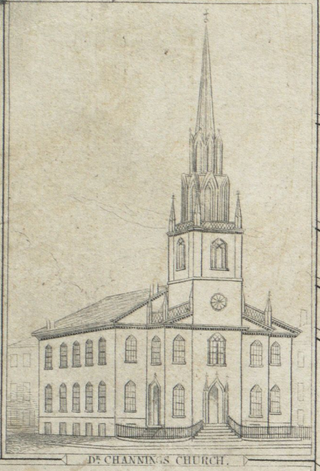
The Boston-area trolleybus system formed part of the public transportation network serving Greater Boston in the U.S. state of Massachusetts. It opened on April 11, 1936, with a large network operating for the next quarter-century. Measured by fleet size, the Boston-area system was the second-largest trolleybus system in the United States at its peak, with only the Chicago system having more trolleybuses than Boston's 463. After 1963, the only remaining portion was a four-route cluster operating from the Harvard bus tunnel at Harvard station, running through Cambridge, Belmont, and Watertown. The Massachusetts Bay Transportation Authority took over the routes in 1964.

Sarah Wentworth Apthorp Morton was an American poet.
The Boston Board of Selectmen was the governing board for the town of Boston from the 17th century until 1822. Selectmen were elected to six-month terms early in the history of the board, but later were elected to one-year terms.

The First Baptist Church is a historic American Baptist Churches USA congregation, established in 1665. It is one of the oldest Baptist churches in the United States. It first met secretly in members homes, and the doors of the first church were nailed shut by a decree from the Puritans in March 1680. The church was forced to move to Noddle's Island. The church was forced to be disguised as a tavern and members traveled by water to worship. Rev. Dr. Stillman led the church in the North End for over 40 years, from 1764 to 1807. The church moved to Beacon Hill in 1854, where it was the tallest steeple in the city. After a slow demise under Rev. Dr. Rollin Heber Neale, the church briefly joined with the Shawmut Ave. Church, and the Warren Avenue Tabernacle, and merged and bought the current church in 1881, for $100,000.00. Since 1882 it has been located at the corner of Commonwealth Avenue and Clarendon Street in the Back Bay. The interior is currently a pending Boston Landmark through the Boston Landmarks Commission.

Perez Morton was a lawyer and revolutionary patriot in Boston, Massachusetts.

The Bunch-of-Grapes was a tavern located on King Street in Boston in the Province of Massachusetts Bay in the 17th and 18th centuries. It served multiple functions in the life of the town, as one could buy drinks and meet friends, business associates, political co-conspirators. The facade of the Bunch-of-Grapes building featured an iconic sign: "Three gilded clusters of grapes dangled temptingly over the door before the eye of the passer-by."

The Brattle Street Church (1698–1876) was a Congregational and Unitarian church on Brattle Street in Boston, Massachusetts.

The Haymarket Theatre (1796-1803) or Hay-Market Theatre was a theatre in late-18th century Boston, Massachusetts. Organized by Charles Stuart Powell, it occupied a large, wooden building "opposite the Mall on Common Street, near Hatch's Tavern." In addition to dramatic plays, the theatre presented some 62 musical entertainments during its first 5 years. The Haymarket "was seldom used after 1800, and on March 3, 1803, it was offered for sale at auction on the condition that it be removed in 60 days."

The Federal Street Church was a congregational Unitarian church in Boston, Massachusetts. Organized in 1727, the originally Presbyterian congregation changed in 1786 to "Congregationalism", then adopted the liberal theology of its fifth Senior Minister, William Ellery Channing, (1780–1842). For most of the 18th century the church was known as the Long Lane Meeting-House. In 1788, state leaders met in the relatively spacious building to determine Massachusetts' ratification of the United States Constitution. Thereafter the church renamed itself the Federal Street Church in honor of the event. In 1803, it called William Ellery Channing, (1780–1842), as its minister who defined "Unitarian Christianity" and launched the Unitarian movement, making the Federal Street Church one of the first to define itself as Unitarian.

Dock Square in downtown Boston, Massachusetts, is a public square adjacent to Faneuil Hall, bounded by Congress Street, North Street, and the steps of the 60 State Street office tower. Its name derives from its original (17th-century) location at the waterfront. From the 1630s through the early 19th century, it served boats in the Boston Harbor as "the common landing place, at Bendell's Cove," later called Town Dock. "Around the dock was transacted the chief mercantile business of the town." After the waterfront was filled in during the early 19th century, Dock Square continued as a center of commerce for some years. The addition in the 1960s of Government Center changed the scale and character of the square from a hub of city life, to a place one merely passes through. As of the 1950s the square has become largely a tourist spot, with the Freedom Trail running through it. John Winthrop, coming from Salem where he landed as a Puritan from England, ended up "setting up a dock at the head of the cove, and here began the town of Boston, which soon was recognized as the political and economic center of the [Massachusetts Bay] colony.

Merchants Row in Boston, Massachusetts, is a short street extending from State Street to Faneuil Hall Square in the Financial District. Since the 17th century, it has been a place of commercial activity. It sits close to Long Wharf and Dock Square, hubs of shipping and trade through the 19th century. Portions of the street were formerly known as Swing-Bridge Lane, Fish Lane, and Roebuck Passage.

Cornhill was a street in Boston, Massachusetts, in the 18th, 19th and 20th centuries, located on the site of the current City Hall Plaza in Government Center. It was named in 1829; previously it was known as Market Street (1807–1828). In its time, it comprised a busy part of the city near Brattle Street, Court Street and Scollay Square. In the 19th century, it was the home of many bookstores and publishing companies. As of 1969, Cornhill exists as 144 feet along the edge of City Hall Plaza.

The Boston Gaol (1635–1822) was a jail in the center of Boston, Massachusetts, located off Court Street, in the block bounded by School, Washington and Tremont Streets. It was rebuilt several times on the same site, before finally moving to the West End in 1822. Prisoners included Quakers, "witches," pirates, murderers, rebels, debtors, and newspaper editors.
Nathaniel Stone Simpkins was a bookseller, publisher, and legislator in Massachusetts in the 19th century. He ran a bookshop and circulating library in Boston ca.1820-1830. "In 1835 he established the Barnstable Journal [of Barnstable, Massachusetts], and in 1856 he established the Yarmouth Register" of Yarmouth, Massachusetts. Simpkins served as a "Representative to the General Court of Mass. in 1836, 1850 and 1851."

Peter Oxenbridge Thacher (1752–1802) was a Congregationalist minister in Massachusetts.

Selwyn's Theatre (1867–1870) of Boston, Massachusetts, was established by British-born actor John H. Selwyn. Architect Benjamin F. Dwight designed the building. Personnel included Dexter H. Follet, Arthur Cheney, H.A. M'Glenen, Charles R. Thorne Jr., and Charles Koppitz. In 1871 Selwyn's was renamed the "Globe Theatre."

The Odeon of Boston, Massachusetts, was a lecture and concert hall on Federal Street in the building also known as the Boston Theatre. The 1,300-seat auditorium measured "50 feet square" with "red moreen"-upholstered "seats arranged in a circular order, and above them ... spacious galleries." The Boston Academy of Music occupied the Odeon in the 1830s and 1840s Notable events at the Odeon included "the first performance in Boston of a Beethoven symphony."
Timeline of Newport, Rhode Island.















